Assessment of Petobo Flowslide Induced by Soil Liquefaction during 2018 Palu–Donggala Indonesian Earthquake
Abstract
1. Introduction
2. Study Site
3. Geological Setting
4. Seismic Motion
5. Methods
5.1. Electrical Resistivity Imaging
5.2. Boring and In-Situ Testing
5.3. Groundwater Level Monitoring
5.4. Scenarios for Assesment and Simulation
5.5. Liquefaction Assessment
5.6. Flowslide Simulation
6. Results
6.1. Groundwater Monitoring
6.2. ERI Profiles
6.3. Material Stratification
6.4. Liquefaction Analysis
6.5. Flowslide Evaluation
7. Discussion
8. Summary and Conclusions
- (1)
- As revealed by field investigations through drilling, probing and sounding, the subsurface material profile of the Petobo site generally consists of sandy deposits of SM/SP/SW, except for the toe portion where thick layers of silt (ML) and clay (CL) are found. The field investigations also confirmed the onsite sandy deposits with measured permeability of 10−4~10−2 cm/sec, equivalent to a range for clean sands to sandy gravels.
- (2)
- A year of groundwater monitoring conducted approximately one and a half years after the sliding incident indicated that the groundwater tables at the crest and upstream portions of the slide footprint are significantly lower than the levels at the time of the earthquake, suggesting that the anthropogenic efforts through the irrigation system and wet paddies would have a profound influence on the local groundwater levels, and that the ground condition would be very sensitive to the infiltration of surface waters.
- (3)
- Liquefaction assessments indicate that scenarios 1 and 2 would cause the soil liquefaction of shallower deposits in the middle and upstream portions of the Petobo site, in its post-slide and pre-slide geometries, respectively, with high groundwater tables due to the 2018 earthquake. In the toe portion, the assessment generally shows no sign of liquefaction, which may have been due to the soil deposit consisting mostly of silts and clays.
- (4)
- In the flowslide simulation of scenario 1, it is obvious that the failed slope reached a stabilized geometry, with a larger portion of the level ground that would prevent the further movement of the slope, even if zones of liquefaction may have still existed in the failed mass. The stabilized geometry of a major portion of the failed slope would provide sufficient resistance against sliding promoted by the unstable portions due to soil liquefaction.
- (5)
- The flowslide simulation of Scenario 2 confirms the 2018 sliding at the Petobo site. Liquefaction assessment showed that soil liquefaction existed in the slope due to shaking. A slight inclination of the pre-slide ground of approximately 3° would provide static shears and trigger a long-distance sliding of the slope after shaking and liquefaction. The simulation indicates that sliding was initiated at around 33 s, about the same time as the start of earthquake shaking, and ceased at approximately 240 s of computation time.
- (6)
- The flowslide simulation of scenario 3 verifies that the sliding at the Petobo site due to the 2018 shaking would not be possible, if the local groundwater levels remained low due to a lack of infiltration of the Gumbasa irrigation system and onsite wet paddy fields. The results demonstrate that the adverse effects originating from human activities, constantly recharging the groundwater through the leaking irrigation system and onsite wet paddy fields, locally raised the groundwater levels and increased the risk of soil liquefaction and flowslide.
- (7)
- In conclusion, this study suggests that the liquefaction-induced sliding in the Petobo area would have been due to the liquefiable sandy deposits, locally raised groundwater tables, a strong shaking that triggered extensive soil liquefaction, and gently sloping ground that provided static shears and promoted long-distance sliding.
Author Contributions
Funding
Institutional Review Board Statement
Informed Consent Statement
Data Availability Statement
Acknowledgments
Conflicts of Interest
References
- Bradley, K.; Mallick, R.; Andikagumi, H.; Hubbard, J.; Meilianda, E.; Switzer, A.; Du, N.; Brocard, G.; Alfian, D.; Benazir, B.; et al. Earthquake-triggered 2018 Palu valley landslides enabled by wet rice cultivation. Nat. Geosci. 2019, 12, 935–939. [Google Scholar] [CrossRef]
- Mason, H.B.; Gallant, A.P.; Hutabarat, D.; Montgomery, J.; Reed, N.; Wartman, J.; Irsyam, M.; Prakoso, W.; Djarwadi, D.; Harnanto, D.; et al. The 28 September 2018 M7.5 Palu–Donggala, Indonesia Earthquake: Version 1.0. Geotechnical Extreme Events Reconnaissance Association Report; GEER-061. 2019. Available online: https://ciptakarya.pu.go.id/admin/assets/upload/galeri/gempa/2023/02/16/163467_8_Geotechnical%20Extreme%20Events%20Reconnaissance%20The%2028%20September%202018%20M7.5%20Palu%20-%20Donggala,%20Indonesia%20Earthquake%20(VERSION%201.0_%203%20APRIL%202019).pdf (accessed on 1 July 2019).
- Miyajima, M.; Setiawan, H.; Yoshida, M.; Ono, Y.; Kosa, K.; Oktaviana, I.S.; Irdhiani, M. Geotechnical damage in the 2018 Sulawesi earthquake, Indonesia. Geoenvironmental Disasters 2019, 6, 6. [Google Scholar] [CrossRef]
- Watkinson, I.M.; Hall, R. Impact of communal irrigation on the 2018 Palu earthquake triggered landslides. Nat. Geosci. 2019, 12, 940–945. [Google Scholar] [CrossRef]
- Gallant, A.P.; Montgomery, J.; Mason, H.B.; Hutabarat, D.; Reed, A.N.; Wartman, J.; Irsyam, M.; Simatupang, P.T.; Alatas, I.M.; Prakoso, W.A.; et al. The Sibalaya Flowslide initiated by the 28 September 2018 MW 7.5 Palu–Donggala, Indonesia earthquake. Landslides 2020, 17, 1925–1934. [Google Scholar] [CrossRef]
- Hidayat, R.F.; Kiyota, T.; Tada, N.; Hayakawa, J.; Nawir, H. Reconnaissance on liquefaction-induced flow failure caused by the 2018 Mw 7.5 Sulawesi earthquake, Palu, Indonesia. J. Eng. Technol. Sci. 2020, 52, 51–65. [Google Scholar] [CrossRef]
- Kiyota, T.; Furuichi, H.; Hidayat, R.; Tada, N.; Nawir, H. Overview of long-distance flow-slide caused by the 2018 Sulawesi earthquake, Indonesia. Soils Found. 2020, 60, 722–735. [Google Scholar] [CrossRef]
- Kusumawardani, R.; Chang, M.; Upomo, T.C.; Huang, R.C.; Fansuri, M.H.; Prayitno, G.A. Understanding of Petobo liquefaction flowslide by 2018.09.28 Palu–Donggala Indonesia earthquake based on site reconnaissance. Landslides 2021, 18, 3163–3182. [Google Scholar] [CrossRef]
- National Agency for Disaster Management. Infografis Gempabumi M7,4 dan Tsunami Sulawesi Tengah update 5 February 2019, pukul 20.00 WIB. Available online: https://bnpb.go.id/infografis/infografis-gempabumi-m74-tsunami-sulawesi-tengah (accessed on 1 July 2019).
- Hungr, O.; Leroueil, S.; Picarelli, L. The Varnes classification of landslide types, an update. Landslides 2014, 11, 167–194. [Google Scholar] [CrossRef]
- Mason, H.B.; Montgomery, J.; Gallant, A.P.; Hutabarat, D.; Reed, A.N.; Wartman, J.; Irsyam, M.; Simatupang, P.T.; Alatas, I.M.; Prakoso, W.A.; et al. East Palu Valley flowslides induced by the 2018 MW 7.5 Palu–Donggala earthquake. Geomorphology 2021, 373, 107482. [Google Scholar] [CrossRef]
- Japan International Cooperation Agency and PT Indra Karya. Boring Survey for Basic Response for Central Sulawesi Earthquake (Phase 1) under the Japan International Cooperation Agency Survey for Disaster Information Collection in Indonesia; JICA: Tokyo, Japan, 2019.
- Center of Data and Information Technology of Indonesia. Lidar Data of Petobo Area before and after Palu Earthquake 2018; Ministry of Public Works and Public Housing of the Republic of Indonesia: Jakarta, Indonesia, 2020.
- Risna, W. Geological Investigation on the Liquefaction Potential of Palu Area, Central Sulawesi Province. Research Report. Geological Agency; Indonesian Ministry of Energy and Miineral Resources: Jakarta, Indonesia, 2012; (In Indonesian).
- Thein, P.S.; Pramumijoyo, S.; Brotopuspito, K.S.; Kiyono, J.; Wilopo, W.; Furukawa, A.; Setianto, A. Estimation of seismic ground motion and shaking parameters based on microtremor measurements at Palu city, Central Sulawesi province, Indonesia. Int. J. Geol. Environ. Eng. 2014, 8, 308–319. [Google Scholar]
- Watkinson, I.M.; Hall, R. Fault systems of the eastern Indonesian triple junction: Evaluation of Quaternary activity and implications for seismic hazards. Geol. Soc. 2016, 441, 71–120. [Google Scholar] [CrossRef]
- Patria, A.; Putra, P.S. Development of the Palu–Koro Fault in NW Palu Valley, Indonesia. Geosci. Lett. 2020, 7, 104659. [Google Scholar] [CrossRef]
- He, L.; Feng, G.; Li, Z.; Feng, Z.; Gao, H.; Wu, X. Source parameters and slip distribution of the 2018 Mw 7.5 Palu, Indonesia earthquake estimated from space-based geodesy. Tectophysics 2019, 772, 228216. [Google Scholar] [CrossRef]
- Walpersdorf, A.; Vigny, C.; Subarya, C.; Manurung, P. Monitoring of the Palu-Koro fault by GPS. Geophys. Res. Lett. 1998, 25, 2313–2316. [Google Scholar] [CrossRef]
- Sukamto, R. Reconnaissance Geologic Map of Palu Area, Sulawesi—Scale 1:250 000; Geological Survey of Indonesia, Directorate of Mineral Resources (Quadrangles 2015-2115); Geological Research and Development Centre: Ottawa, Canada, 1973.
- Hanifa, R. GEER–HATTI–PuSGeN Joint Survey on Palu Earthquake 2018 (M7. 4) 13-18 Nov 2018 Presentation; Indonesian Ministry of Research, Technology and Higher Education: Jakarta, Indonesia, 2018.
- Indonesian Agency for Meteorological, Climatological and Geophysics. Review of Ground Shaking due to the Donggala Earthquake on 28 September 2018. Available online: https://www.bmkg.go.id/berita/?p=ulasan-guncangan-tanah-akibat-gempabumi-utara-donggala-sulteng-28-september-2018&lang=ID&tag=ulasan-guncangan-tanah (accessed on 24 August 2019). (In Indonesian).
- Stan-Kłeczek, I.; Stan, D. Application of the ERT to recognise the geological structure of frost-riven clifs localised in the Skalny Potok (Hrubý Jeseník Mts.). Acta Geophys. 2019, 67, 1759–1764. [Google Scholar] [CrossRef]
- Samouëlian, A.; Cousin, I.; Tabbagh, A.; Bruand, A.; Richard, G. Electrical resistivity survey in soil science: A review. Soil Tillage Res. 2005, 83, 173–193. [Google Scholar] [CrossRef]
- Salleh, A.N.; Muztaza, N.M.; Sa’ad, R.; Zakaria, M.T.; Mahmud, N.; Rosli, F.N.; Samsudin, N. Application of geophysical methods to evaluate soil dynamic properties in Penang Island, Malaysia. J. Asian Earth Sci. 2021, 207, 1–12. [Google Scholar] [CrossRef]
- Loke, M.H. Electrical Imaging Surveys for Environmental and Engineering Studies: A Practical Guide to 2D and 3D Surveys. Geotomo Software; Penang Publishers: Penang, Malaysia, 1999. [Google Scholar]
- Reynolds, J.M. An Introduction to Applied Environmental Geophysics; Wiley: New York, NY, USA, 1997. [Google Scholar]
- Loke, M.H. Rapid 2-D Resistivity and IP Inversion Using the Least-Squares Method; Geotomo Software; Penang Publishers: Penang, Malaysia, 2018. [Google Scholar]
- Seed, H.B.; Tokimatsu, K.; Harder, L.F.; Chung, R.M. Influence of SPT procedures in soil liquefaction resistance evaluations. J. Geotech. Eng. 1985, 111, 1425–1445. [Google Scholar] [CrossRef]
- Sy, A.; Campanella, R.G. An alternative method of measuring SPT energy. In Proceedings of the 2nd International Conference Recent Advances in Geotechnical Earthquake Engineering and Soil Dynamics, St. Louis, MO, USA, 11–15 March 1991. [Google Scholar]
- Abou-matar, H.; Goble, G.G. SPT dynamic analysis and measurements. J. Geotech. Geoenvironmental Eng. 1997, 123, 921–928. [Google Scholar] [CrossRef]
- Geotechnical Engineering Office (GEO) Hong Kong. GEOGUIDE II—Guide to Site Investigation; Civil Engineering Department, Hong Kong SAR Government: Hong Kong, China, 1996.
- Youd, T.L.; Idriss, I.M.; Andrus, R.D.; Arango, I.; Castro, G.; Christian, J.; Dobry, R.; Liam Finn, W.D.; Leslie, H.; Hynes, M.E.; et al. Liquefaction resistance of soils: Summary report from the 1996 NCEER and 1998 NCEER/NSF workshops on evaluation of liquefaction resistance of soils. J. Geotech. Geoenvironmental Eng. 2001, 127, 817–833. [Google Scholar] [CrossRef]
- Japan Road Association (JRA). Design code and explanations for roadway bridges, 2017 version. In Part V–Seismic Resistance Design, Japan; Japan Road Association: Tokyo, Japan, 2017. [Google Scholar]
- Seed, H.B.; Idriss, I.M. Analysis of soil liquefaction: Niigata earthquake. J. Soil Mech. Found. Div. 1967, 93, 83–108. [Google Scholar] [CrossRef]
- Seed, H.B. Soil liquefaction and cyclic mobility evaluation for level ground during earthquakes. J. Geotech. Eng. 1979, 105, 201–255. [Google Scholar] [CrossRef]
- Seed, H.B.; Idriss, I.M.; Arango, I. Evaluation of liquefaction potential using field performance data. J. Geotech. Eng. 1983, 109, 458–482. [Google Scholar] [CrossRef]
- Japan Road Association (JRA). Design code and explanations for roadway bridges, 1990 version. In Part V–Seismic Resistance Design, Japan; Japan Road Association: Tokyo, Japan, 1990. [Google Scholar]
- Chang, M.; Chan, M.S.; Huang, R.C.; Upomo, T.C.; Kusumawardani, R. Assignment of Groundwater Table in Liquefaction Analysis of Soils. In Advancements in Geotechnical Engineering. Sustainable Civil Infrastructures; Shehata, H., Badr, M., Eds.; Springer: Berlin/Heidelberg, Germany, 2020; pp. 3–18. [Google Scholar]
- Sassa, K. Geotechnical model for the motion of landslides. In Proceedings of the 5th International Symposium on Landslides, Balkema, Rotterdam, The Netherland, 10–15 July 1988. [Google Scholar]
- Sassa, K.; Wang, G.; Fukuoka, H.; Wang, F.W.; Ochiai, T.; Sugiyama, S.T. Landslide risk evaluation and hazard mapping for rapid and long-travel landslides in urban development areas. Landslides 2004, 1, 221–223. [Google Scholar] [CrossRef]
- Sassa, K.; Setiawan, H.; He, B.; Gradiški, K.; Dang, K. TXT-tool 3.081-1.5: Manual for the LS-RAPID software. In Landslide dynamics: ISDR-ICL Landslide Interactive Teaching Tools; Springer: Berlin/Heidelberg, Germany, 2018; pp. 191–224. [Google Scholar]
- He, B.; Sassa, K.; Nagai, O.; Takara, K. Simulation of a Rapid and Long Travelling Landslide Using 2D-RAPID and LS-RAPID 3D Models. In Landslide Science for a Safer Geoenvironment: Vol. 1: The International Programme on Landslides (IPL); Springer International Publishing: Cham, Switzerland, 2014; pp. 479–484. [Google Scholar]
- Sassa, K.; Nagai, O.; Solidum, R.; Yamazaki, Y.; Ohta, H. An Integrated Model Simulating the Initiation and Motion of Earthquake and Rain Induced Rapid Landslides and Its Application to the 2006 Leyte Landslide. Landslides 2010, 7, 219–236. [Google Scholar] [CrossRef]
- Palacky, G.J. Resistivity characteristics of geological targets. In Electromagnetic Methods in Apllied Geophysics, Theory Society of Exploration Geophysicists; Nabighian, M.N., Ed.; Society of Exploration Geophysicists: Tulsa, OK, USA, 1991; Volume 1, pp. 53–129. [Google Scholar]
- Meads, L.N.; Bentley, L.R.; Mendoza, C.A. Application of electrical resistivity imaging to the development of a geologic model for a proposed Edmonton landfill site. Can. Geotech. J. 2003, 40, 551–558. [Google Scholar] [CrossRef]
- Lee, C.; Tsai, L.L.; Yang, C.; Wen, K.; Wang, Z.; Hsieh, Z.; Liu, H. The identified origin of a linear slope near Chi–Chi earthquake rupture combining 2D, 3D resistivity image profiling and geological data. Environ. Geol. 2009, 58, 1397–1406. [Google Scholar] [CrossRef]
- Ishihara, K. Stability of natural deposits during earthquakes. In Proceedings of the 11th International Conference on Soil Mechanics and Foundation Engineering, San Fransisco, USA, 12–16 August 1985. [Google Scholar]
- Dobry, R. Soil properties and earthquake ground response. In Proceedings of the Tenth European Conference on Soil Mechanics and Foundation Engineering, Florence, Italy, 26–30 May 1991. [Google Scholar]
- Dang, K.; Sassa, K.; Fukuoka, H.; Sakai, N.; Sato, Y.; Takara, K.; Quang, L.H.; Loi, D.H.; Van Tien, P.; Ha, N.D. Mechanism of two rapid and long-runout landslides in the 16 April 2016 Kumamoto earthquake using a ring-shear apparatus and computer simulation (ls-rapid). Landslides 2016, 13, 1525–1534. [Google Scholar] [CrossRef]
- Huy, L.D.; Sassa, K.; Fukuoka, H.; Sato, Y.; Takara, K.; Setiawan, H.; Pham, T.; Dang, K. TXT-tool 3.081-1.4: Initiation Mechanism of Rapid and Long Run-Out Landslide and Simulation of Hiroshima Landslide Disasters Using the Integrated Simulation Model (LS-RAPID). In Landslide Dynamics: ISDR-ICL Landslide Interactive Teaching Tools; Springer: Berlin/Heidelberg, Germany, 2018; pp. 149–168. [Google Scholar]
- Sassa, K.; He, B.; Miyagi, T.; Strasser, M.; Konagai, K.; Ostric, M.; Setiawan, H.; Takara, K.; Nagai, O.; Yamashiki, Y.; et al. A hypothesis of the Senoumi submarine megaslide in Suruga Bay in Japan—Based on the undrained dynamic-loading ring shear tests and computer simulation. Landslides 2012, 9, 439–455. [Google Scholar] [CrossRef]
- Okamura, M.; Ono, K.; Arsyad, A.; Minaka, U.S.; Nurdin, S. Large-scale flowslide in Sibalaya caused by the 2018 Sulawesi earthquake. Soils Found. 2020, 60, 1050–1063. [Google Scholar] [CrossRef]
- Chang, M.; Upomo, T.C.; Prayitno, G.A.; Kusumawardani, R.; Huang, R.C.; Liao, C.M. Subsurface investigation of liquefaction induced Petobo landslide during 28 September 2018 Palu Donggala Indonesia earthquake. Sino-Geotechnics 2022, 173, 111–120, (In Chinese with English abstract). [Google Scholar]
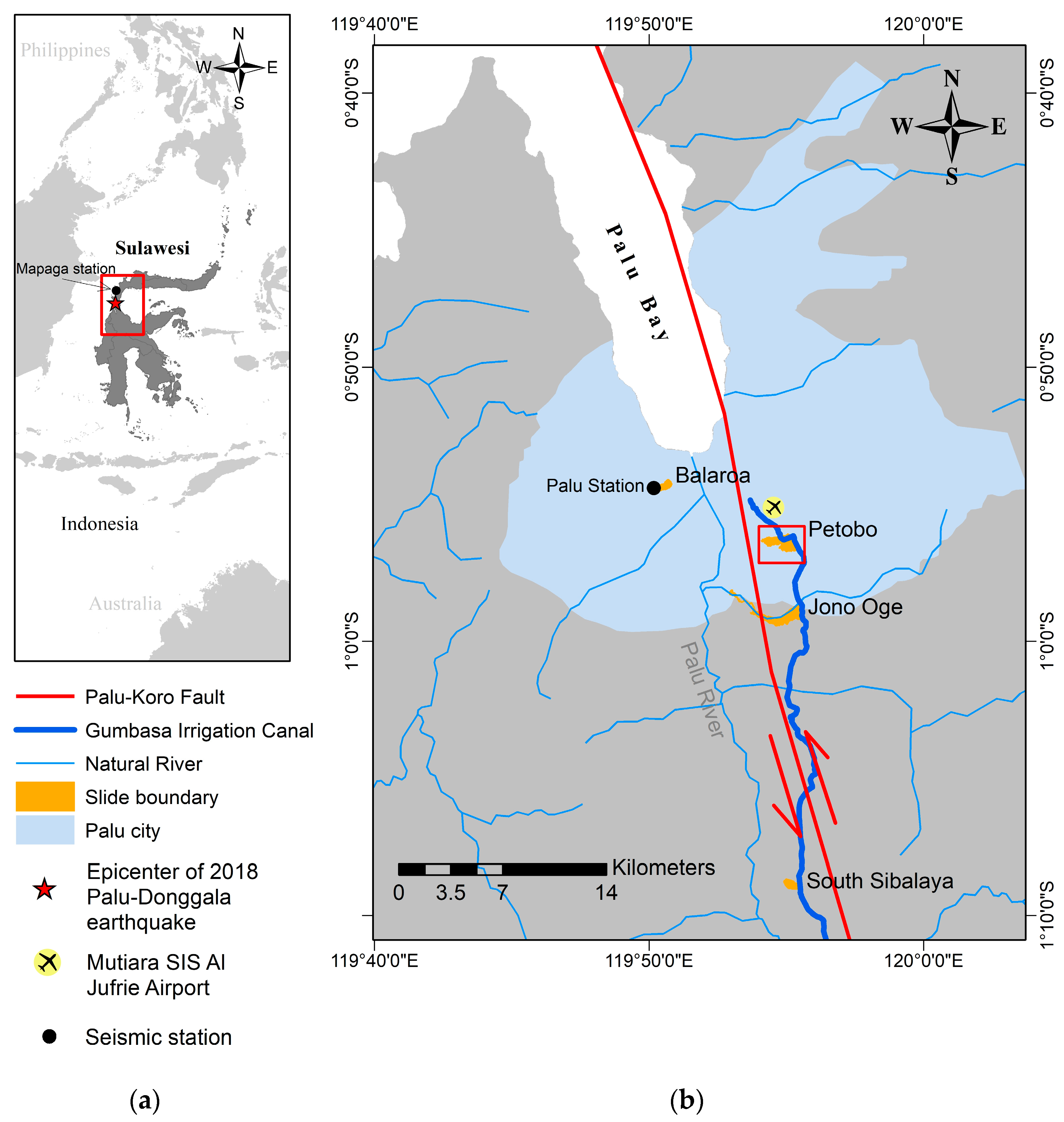

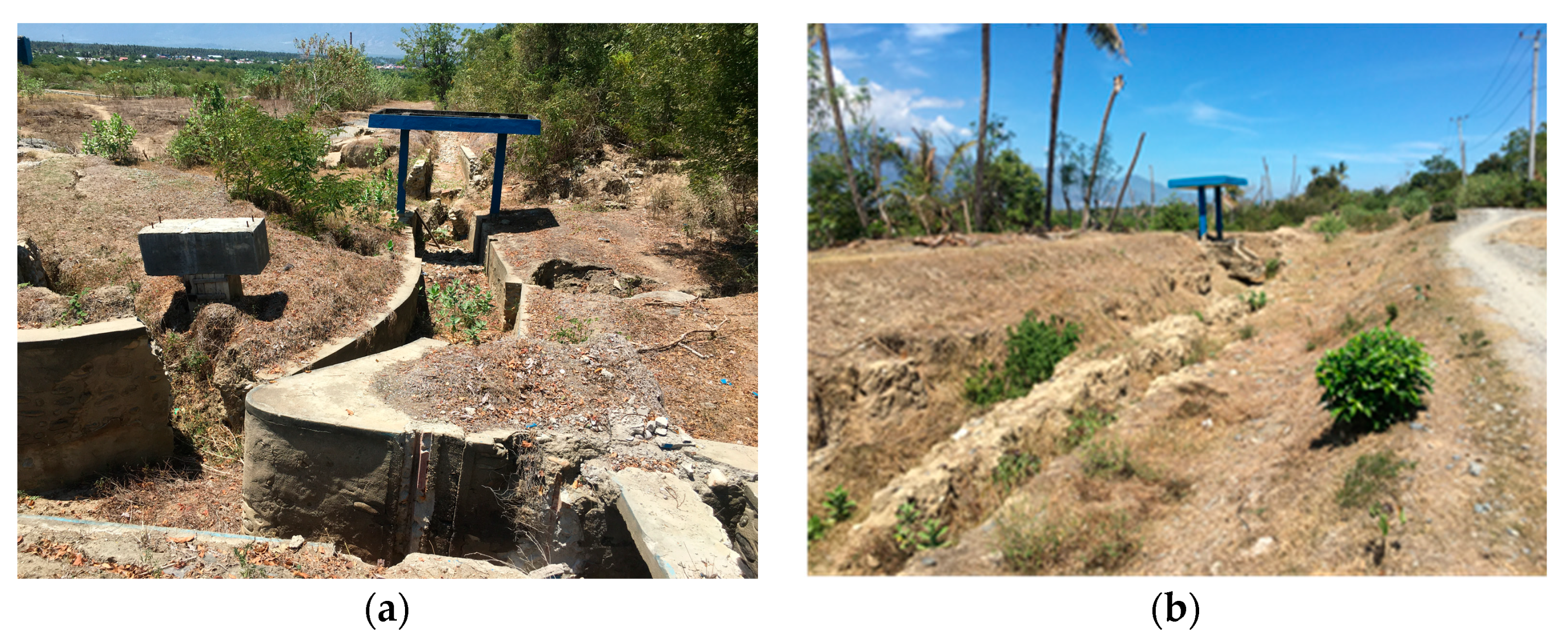
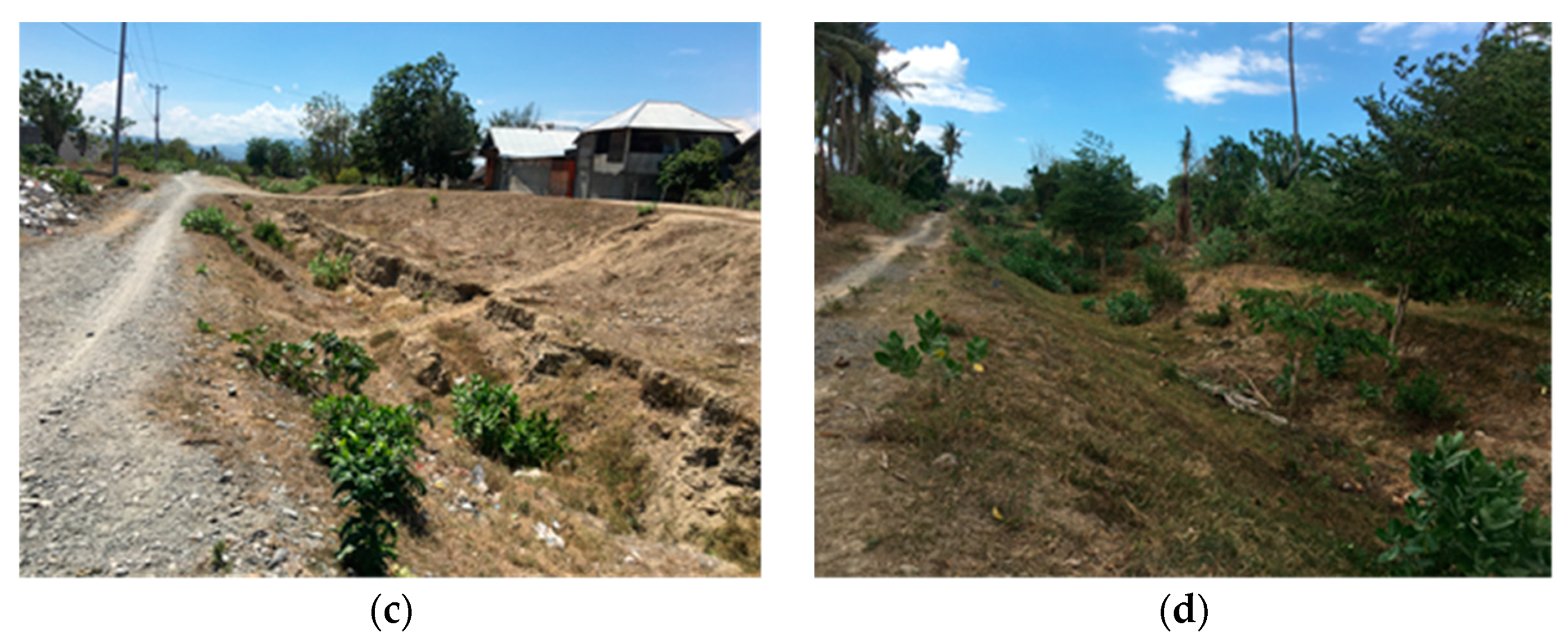
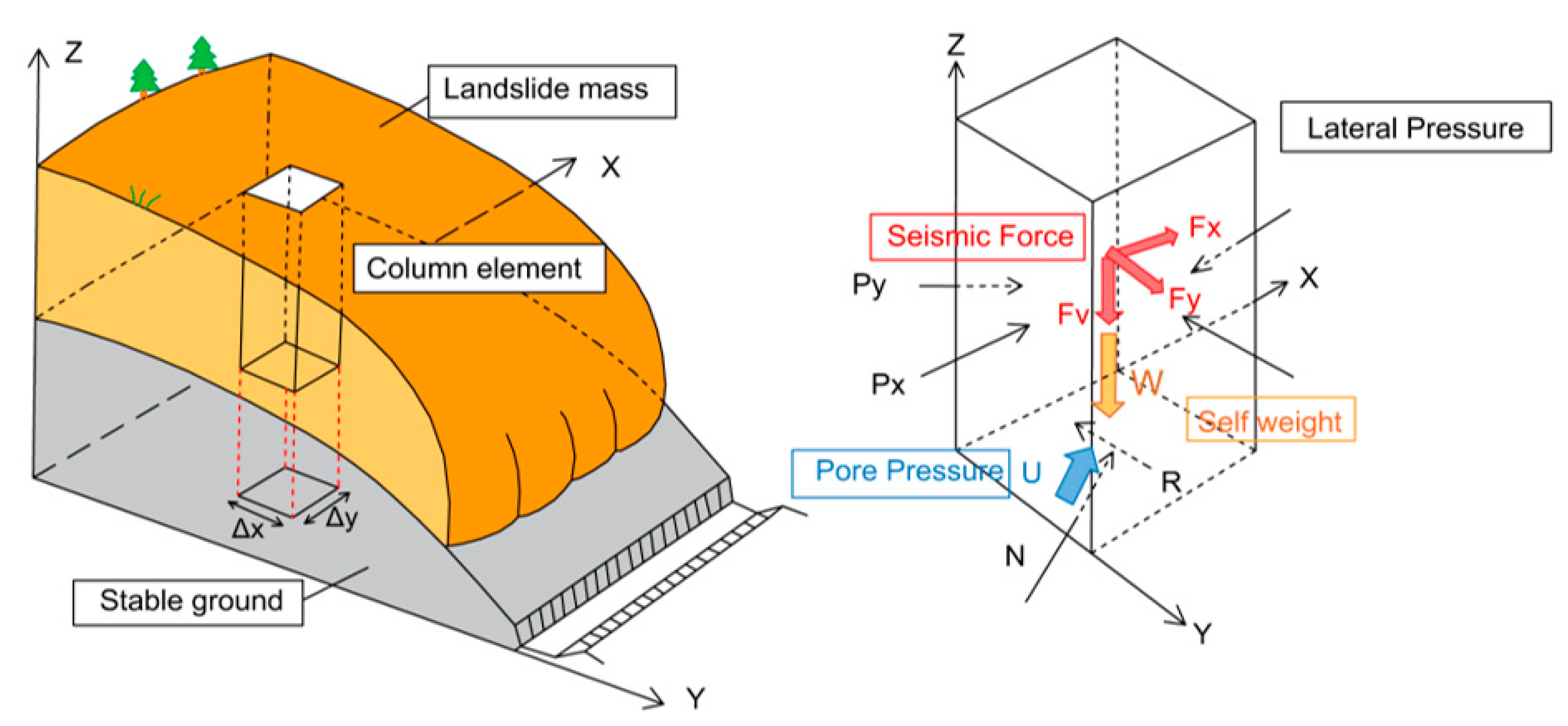
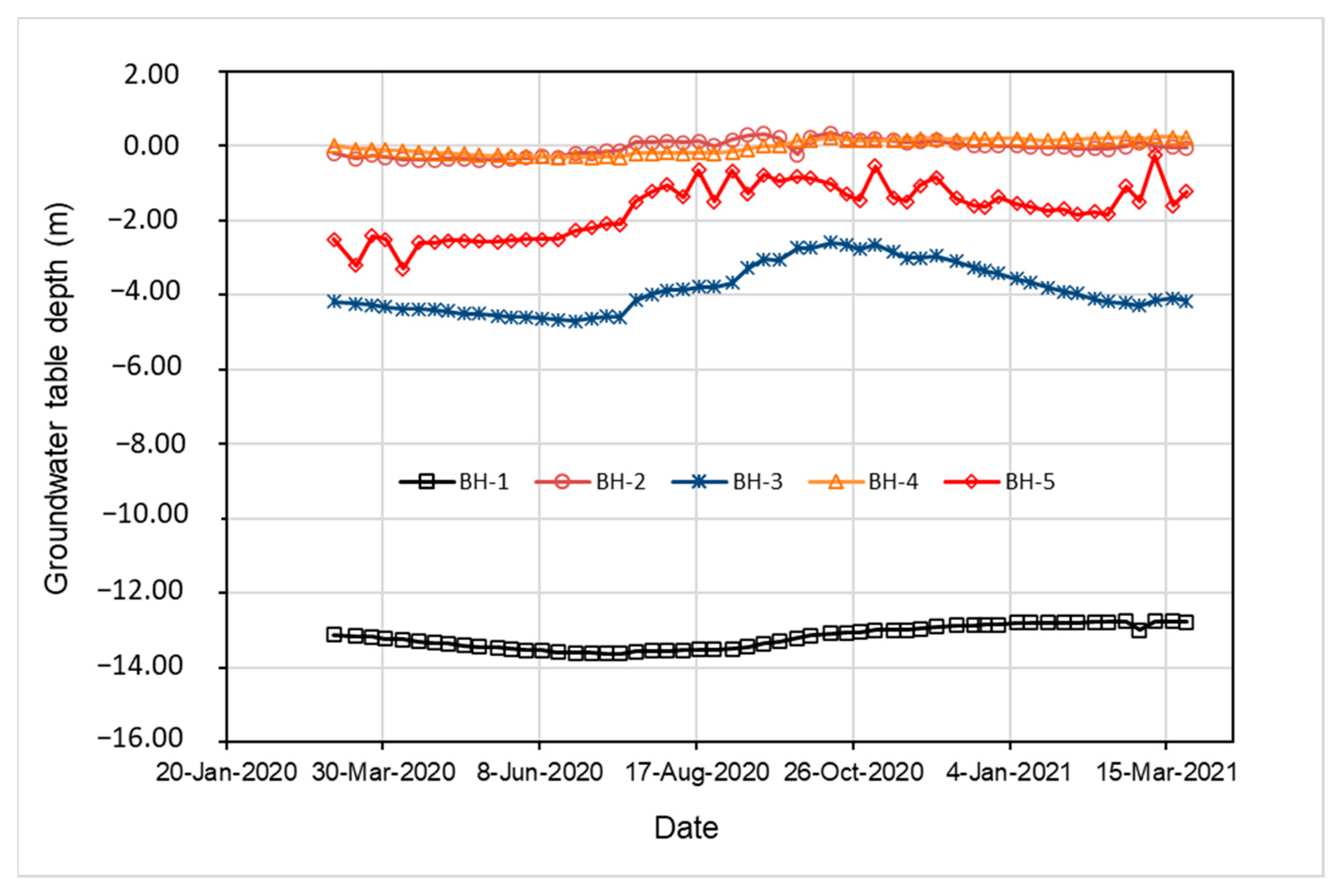

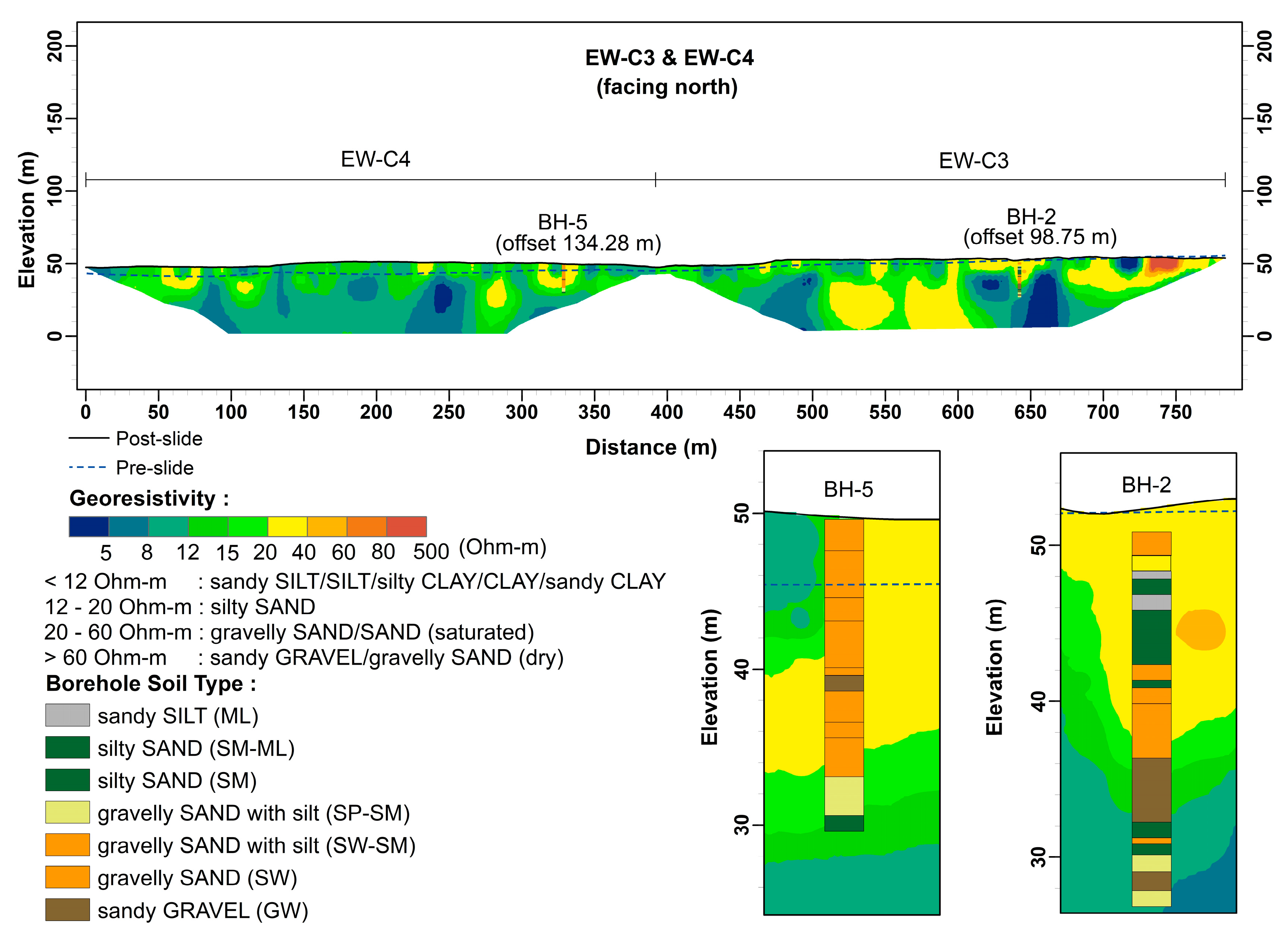
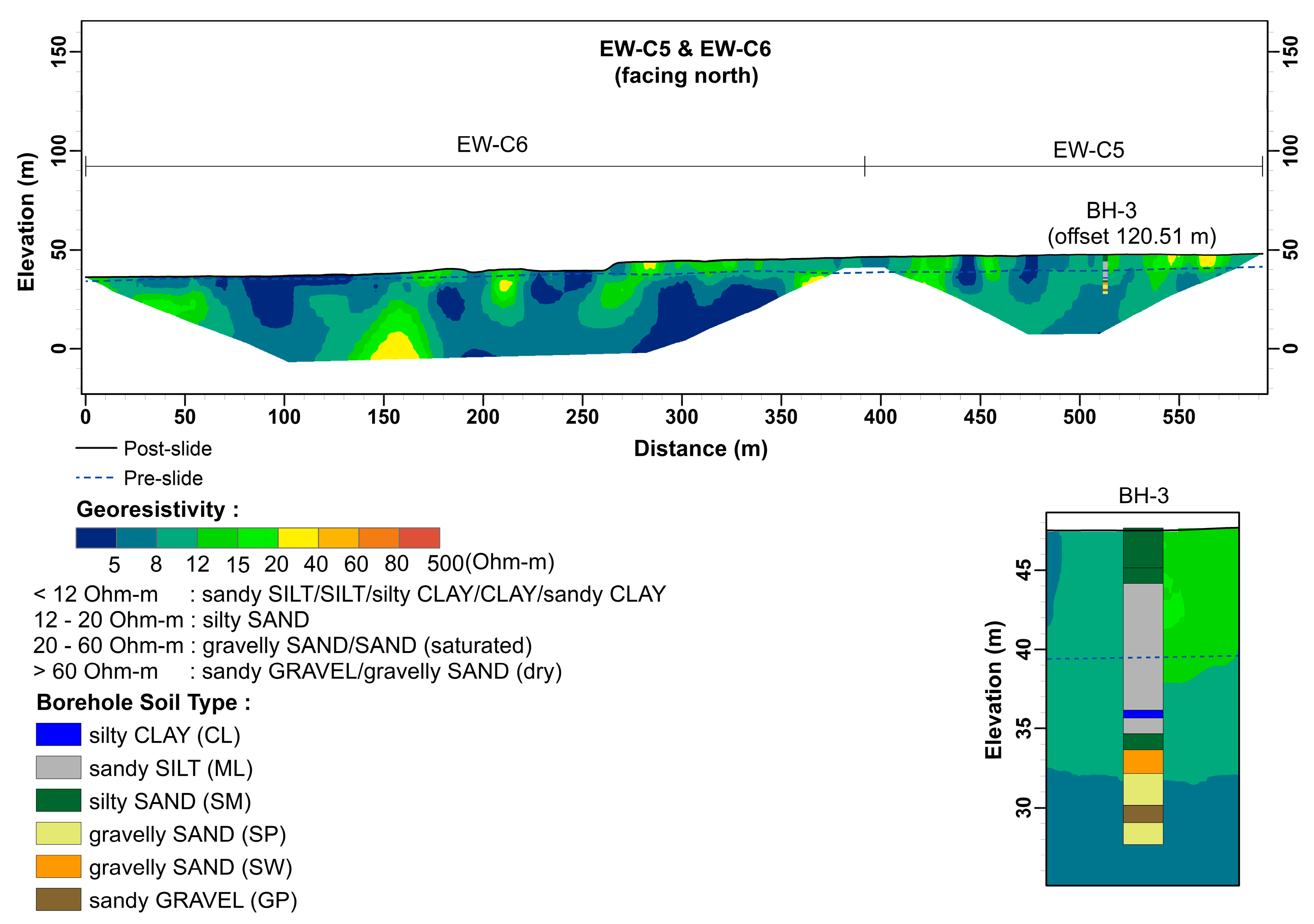
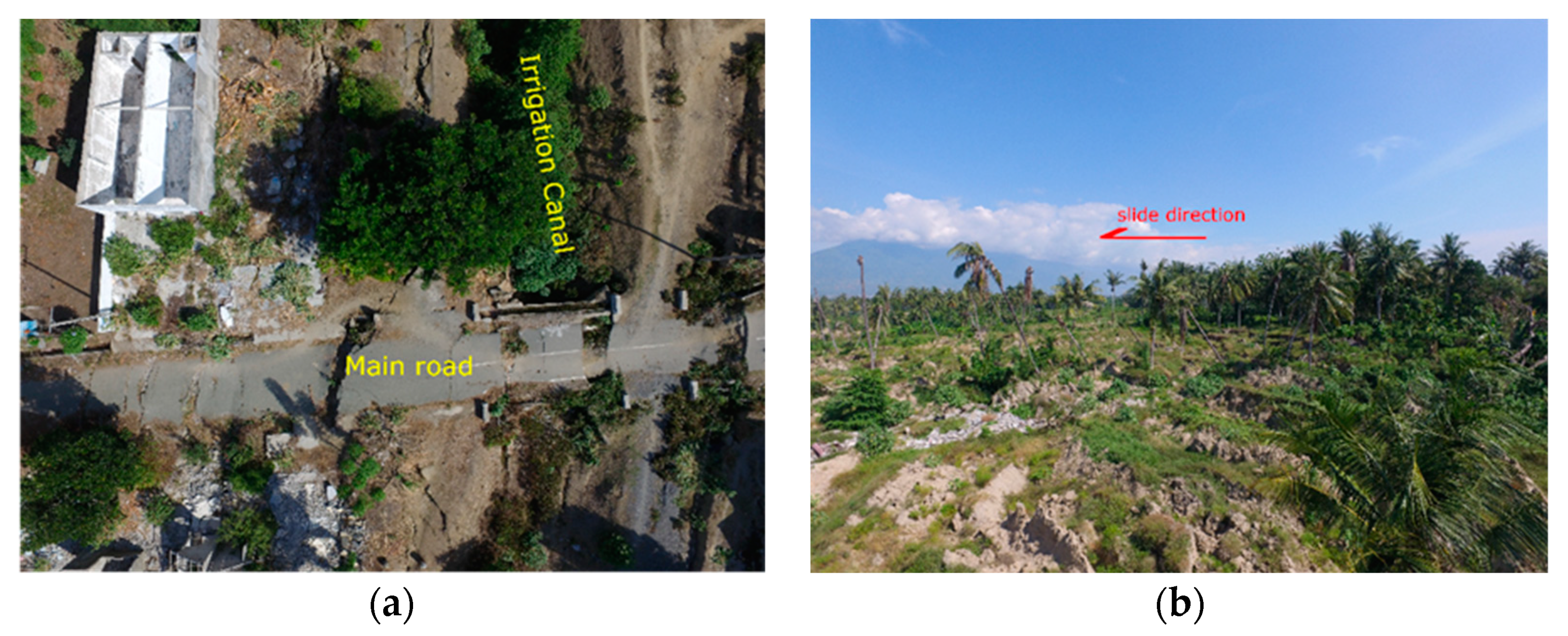

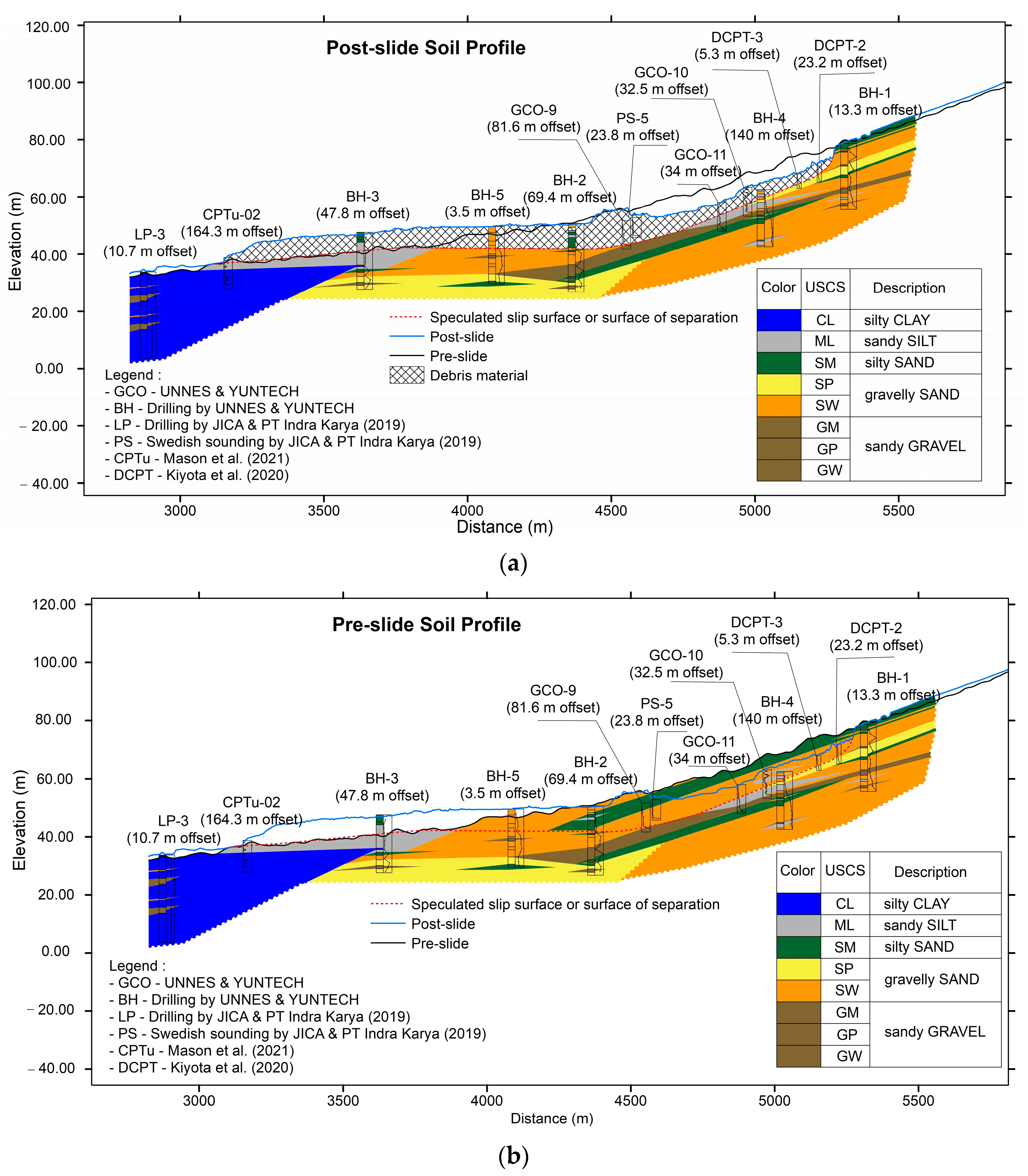
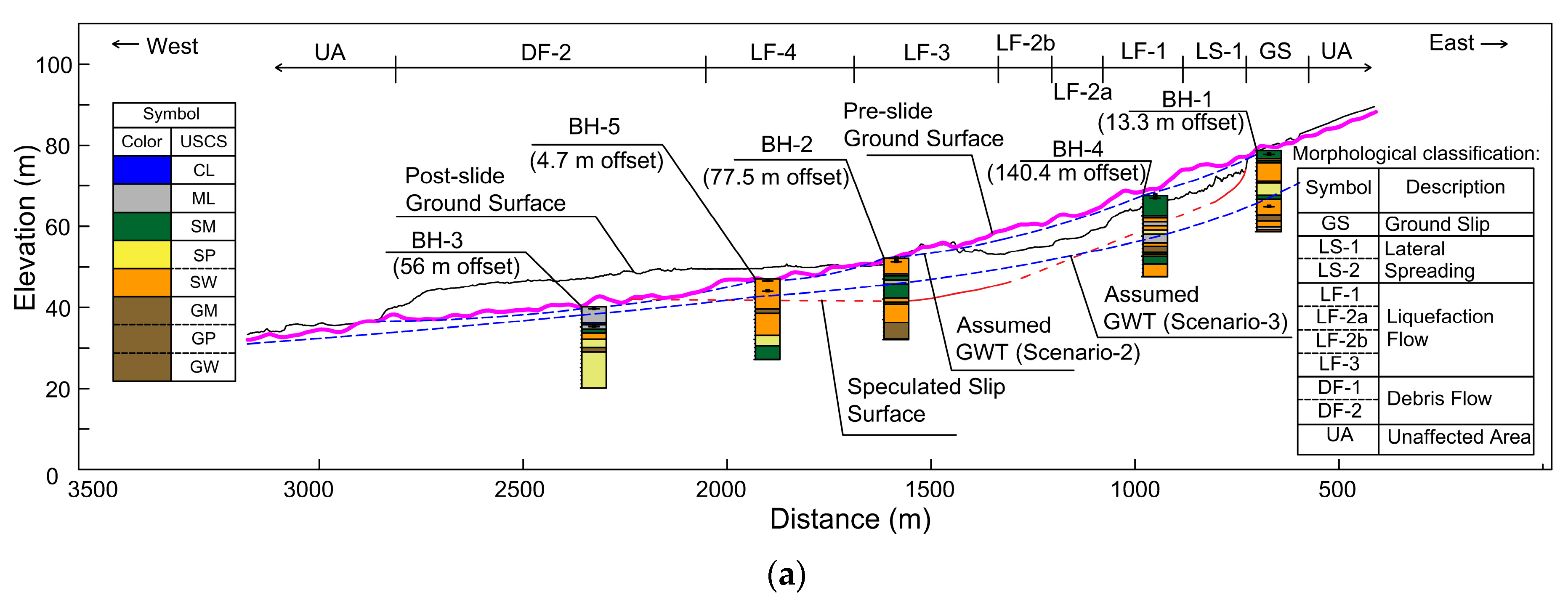
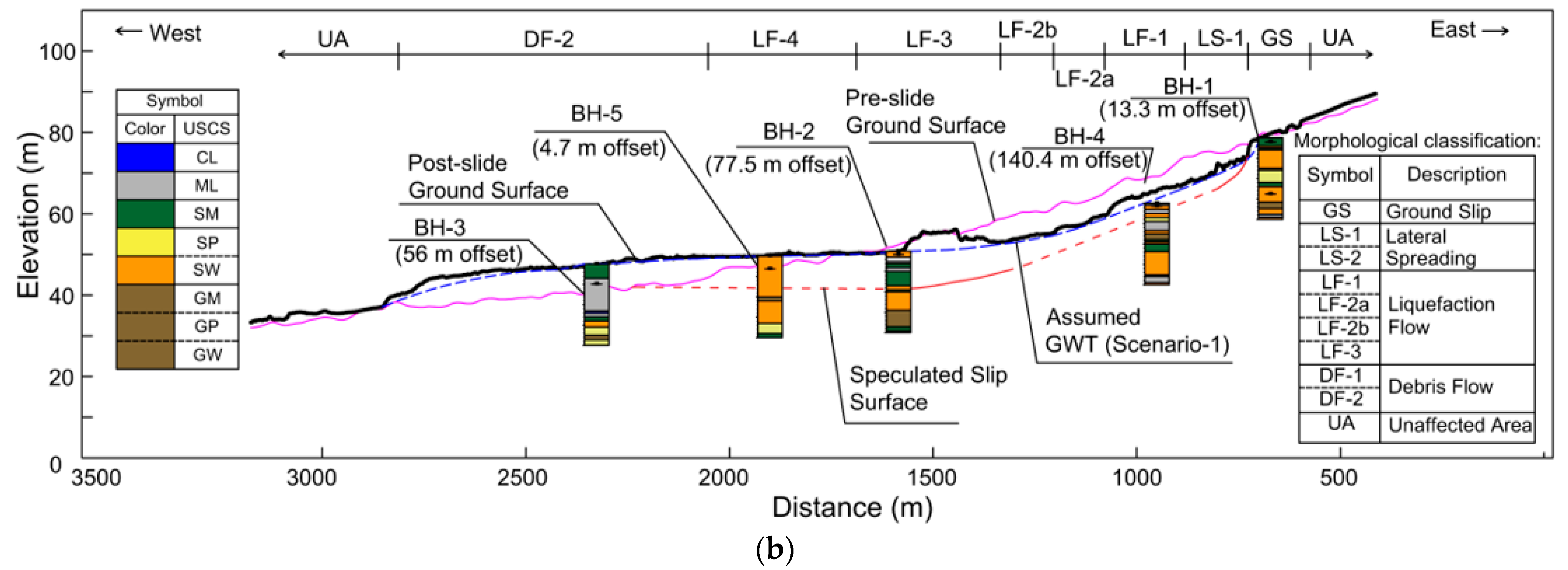
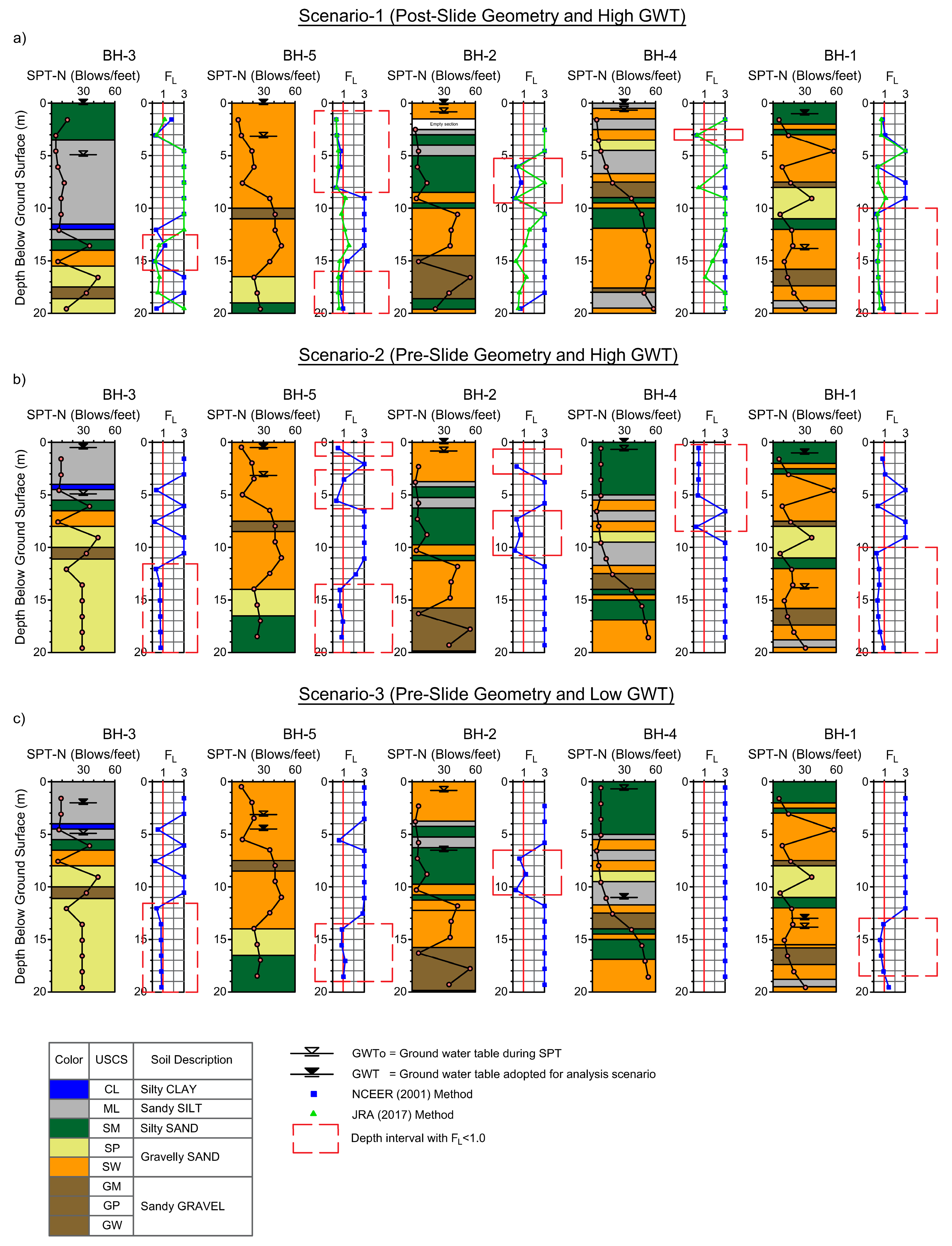

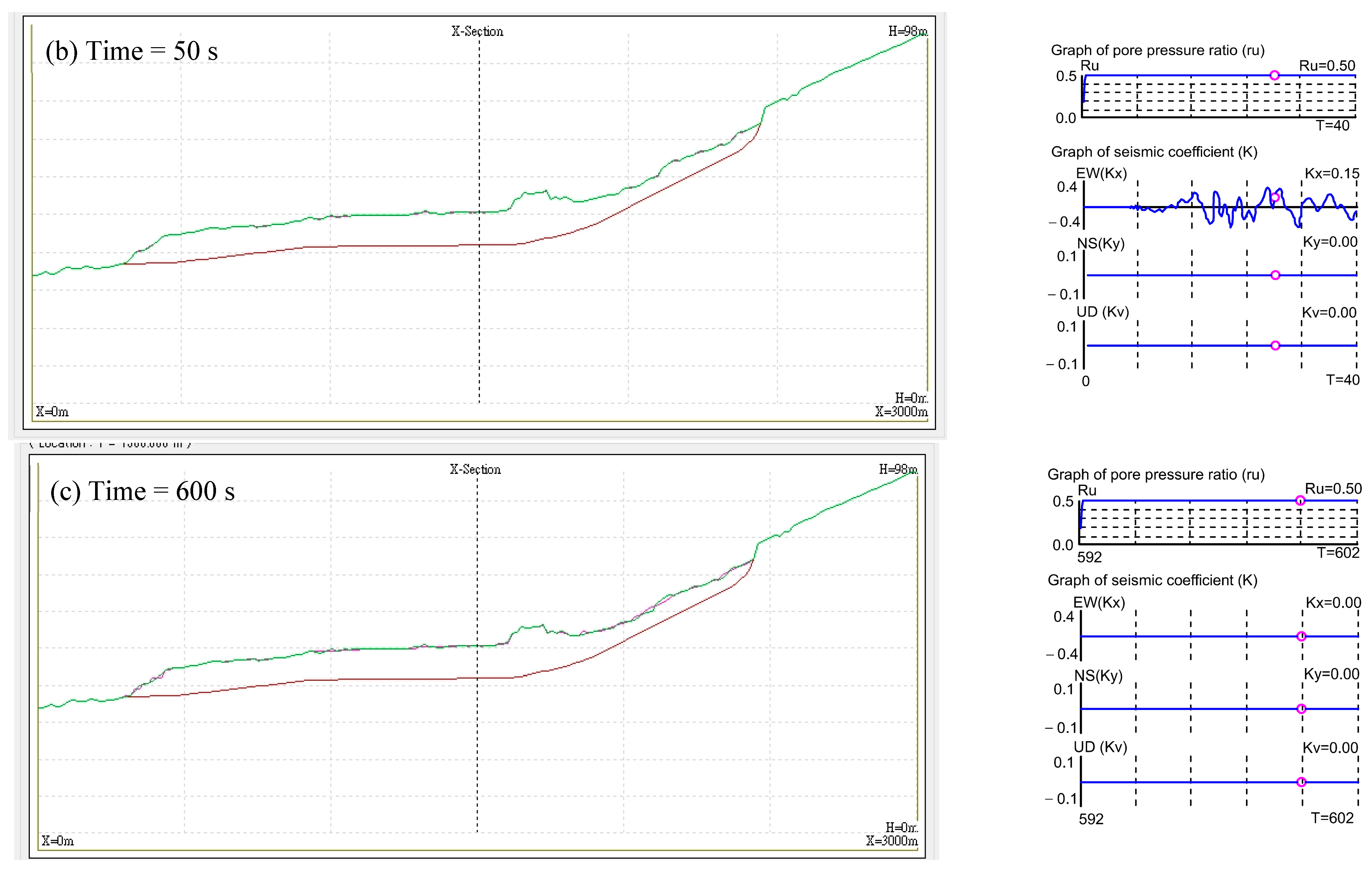
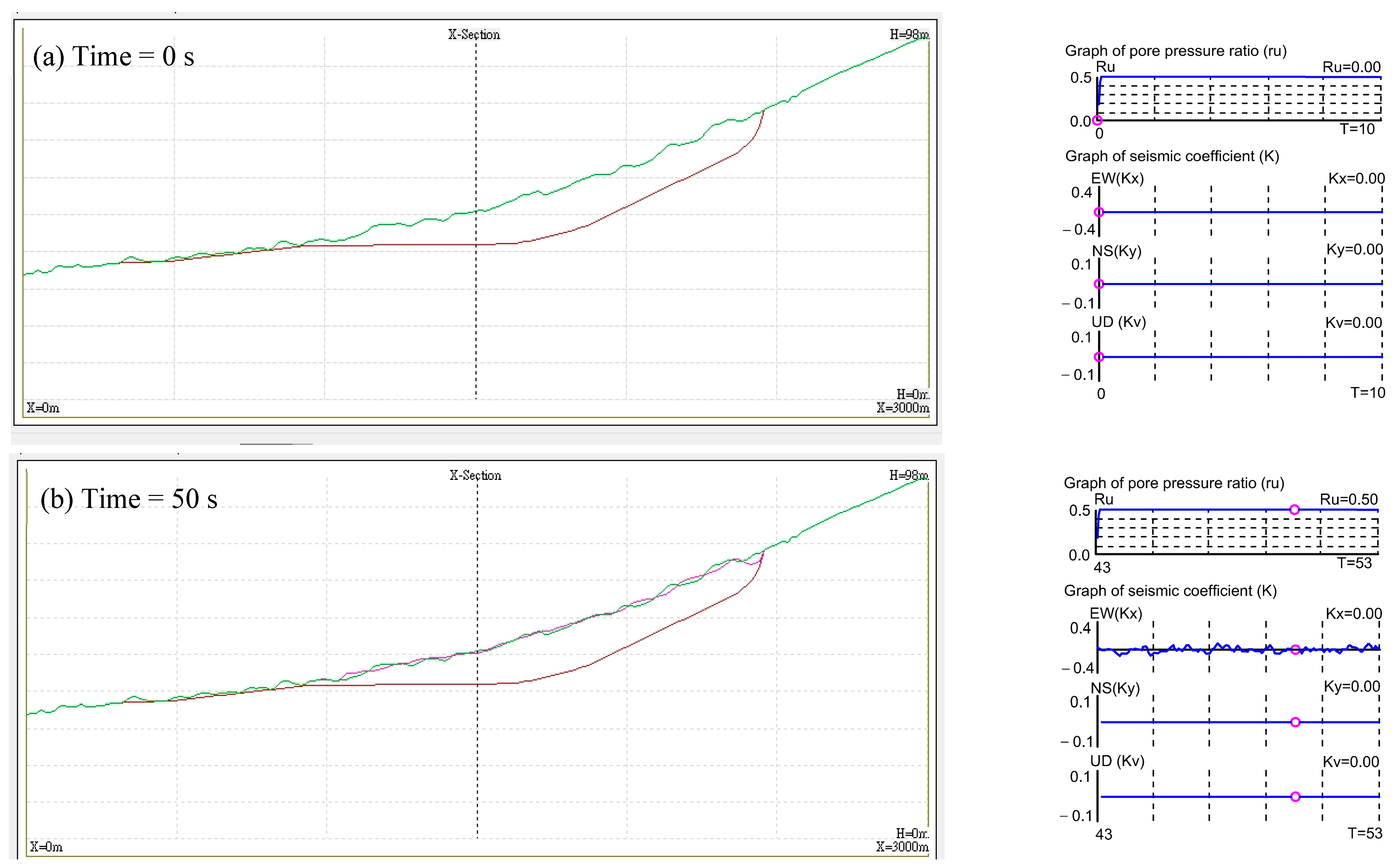

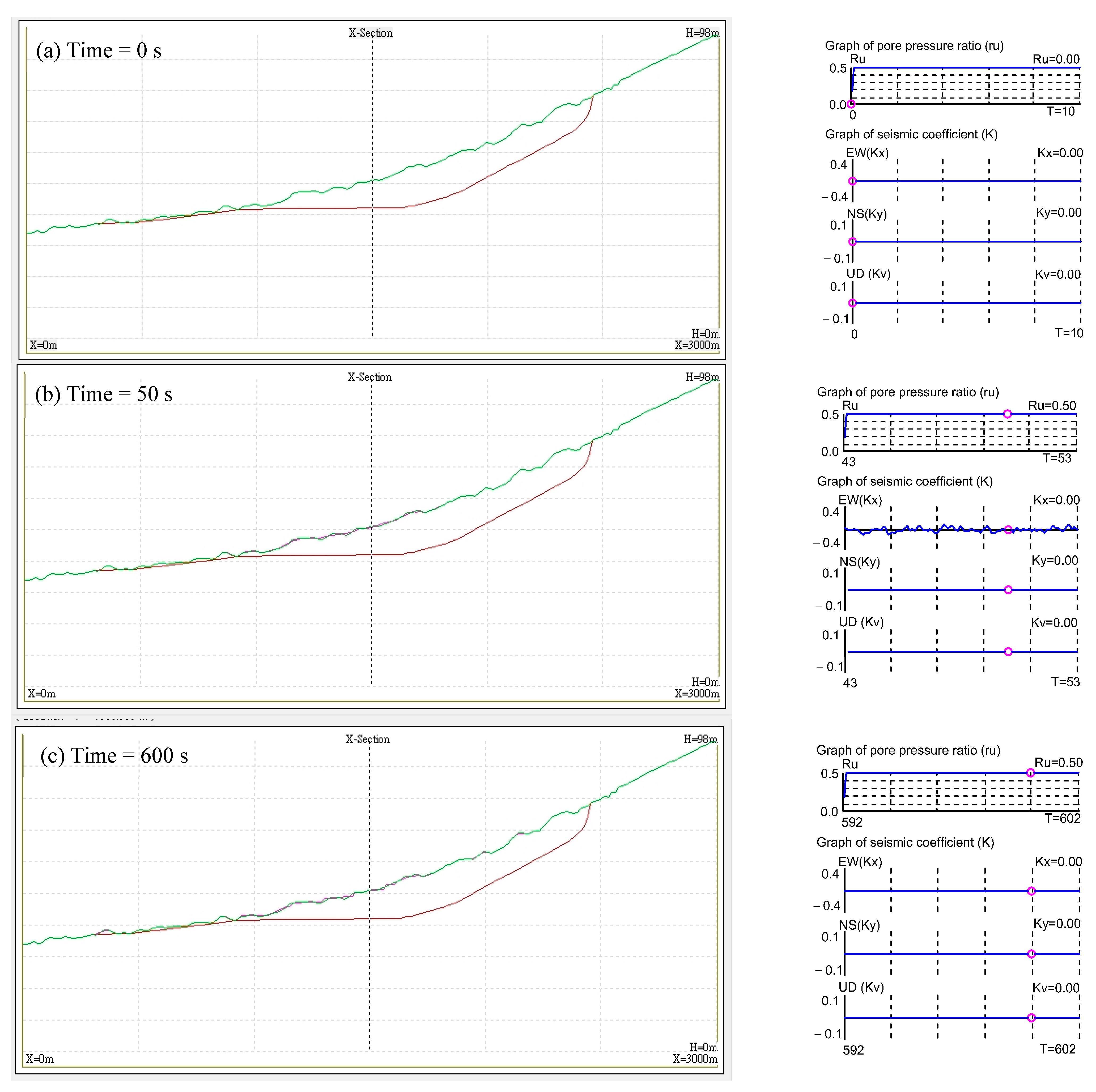
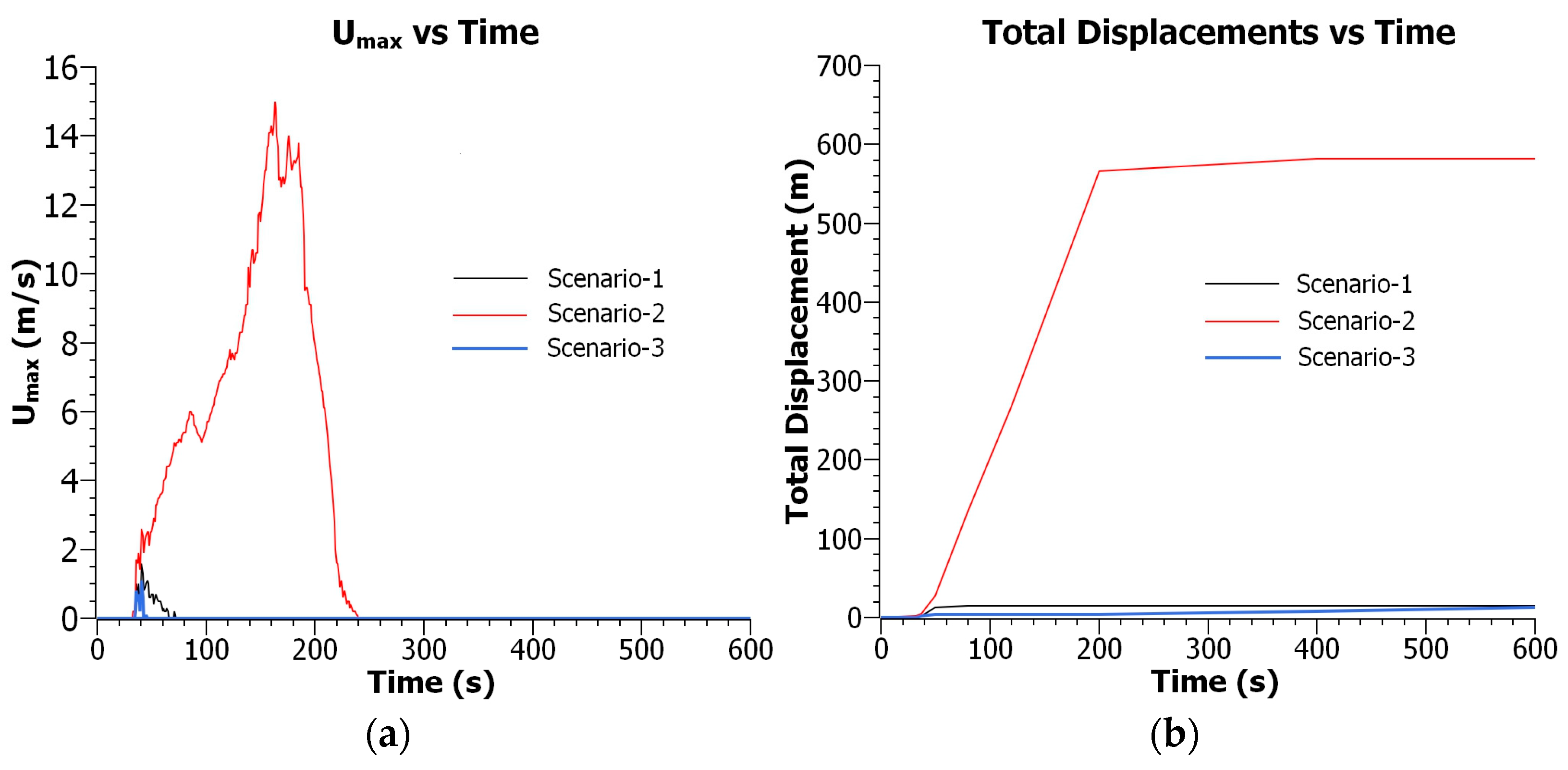
| Scenario | Geometry | Timing and GWT |
|---|---|---|
| (1) | Post-slide | The condition at the cease of sliding if the same earthquake (M = 7.5, PGA = 0.34 g) strikes the site again (post-slide geometry; high GWT) |
| (2) | Pre-slide | The condition when the localized high-raised GWTs, due to the influence of Gumbasa canal, irrigation system and paddy fields, existed at the time of earthquake (pre-slide geometry; high GWT) |
| (3) | Pre-slide | The condition when the local GWTs were not affected by the canal and paddy fields/irrigation system at the time of earthquake (pre-slide geometry; low GWT) |
| Borehole Number | Groundwater Table (m) (Depth from the Ground Surface) | ||
|---|---|---|---|
| Max | Min | Average | |
| BH-1 | −13.63 | −12.75 | −13.18 |
| BH-2 | −0.38 | +0.34 | −0.05 |
| BH-3 | −4.70 | −2.60 | −3.83 |
| BH-4 | −0.30 | +0.25 | −0.01 |
| BH-5 | −3.30 | −0.24 | −1.70 |
| Resistivity Value (ohm-m) | Resistivity Classification | Soil Type Interpretation |
|---|---|---|
| <12 | Low | sandy SILT/SILT/silty CLAY/CLAY/sandy CLAY |
| 12–20 | Moderate–low | silty SAND |
| 20–60 | Moderate–high | gravelly SAND/SAND (saturated) |
| >60 | High | sandy GRAVEL/gravelly SAND (dry) |
| Borehole | Scenario 1 Geometry: Post-Slide GWT: Right after Slide (GWT High) | Scenario 2 Geometry: Pre-Slide GWT: Estimated GWT prior to Slide (GWT High) | Scenario 3 Geometry: Pre-Slide GWT: Estimated GWT without Influences from Canal and Paddy Fields (GWT Low) | |||
|---|---|---|---|---|---|---|
| GWT Depth (m) | Soil Profile | GWT Depth (m) | Soil Profile | GWT Depth (m) | Soil Profile | |
| BH-1 | −1.00 | Post-slide elevation | −1.00 | Same as post-slide elevation | −13.00 | Same as post-slide elevation |
| BH-2 | 0.00 | Post-slide elevation | 0.00 | Post-slide elevation +1.25 m | −6.50 | Post-slide elevation +1.25 m |
| BH-3 | 0.00 | Post-slide elevation | −0.50 | Post-slide elevation −7.50 m | −2.00 | Post-slide elevation −7.50 m |
| BH-4 | 0.00 | Post-slide elevation | 0.00 | Post slide elevation +5.00 m | −11.00 | Post-slide elevation +5.00 m |
| BH-5 | 0.00 | Post-slide elevation | −0.50 | Post-slide elevation −2.50 m | −4.50 | Post-slide elevation −2.50 m |
| LP3 | −0.50 | Post-slide elevation | −0.50 | Same as post-slide elevation | −0.50 | Same as post-slide elevation |
| No | Parameters Used in Simulation | Value | Unit | Remark | |||
|---|---|---|---|---|---|---|---|
| Zone 4 | Zone 3 | Zone 2 | Zone 1 | ||||
| Parameter for each zone | |||||||
| 1 | Friction angle of landslide mass (ϕi) | 15 | 5 | 25 | 33 | deg | - |
| 2 | Lateral earth pressure ratio (k) | 0.741 | 0.913 | 0.577 | 0.455 | - | k = 1 − sinϕi |
| 3 | Friction angle at peak of sliding surface (ϕp) | 5 | 10 | 15 | 20 | deg | - |
| 4 | Cohesion at peak of sliding surface (cp) | 2 | 3 | 4 | 5 | kPa | - |
| 5 | Friction angle during motion at sliding surface (ϕm) | 2.5 | 5 | 7.5 | 10 | deg | - |
| 6 | Steady-state shear resistance of sliding surface (τss) | 5.25 | 1 | 4 | 5 | kPa | - |
| 7 | Rate of excess pore pressure generation (Bss) | 1.0 | 1.0 | 1.0 | 1.0 | - | For Scenarios 1 and 2 |
| 0.0 | 0.2 | 0.7 | 0.0 | - | For Scenario 3 | ||
| Parameter for the whole area | Values for all zones | ||||||
| 8 | Total unit weight of landslide mass (γt) | 20 | kN/m3 | - | |||
| 9 | Cohesion of landslide mass (ci) | 0.5 | kPa | - | |||
| 10 | Cohesion during motion at sliding surface (cm) | 0.1 | kPa | - | |||
| 11 | Shear displacement at the start of strength reduction (DL) | 2 | mm | - | |||
| 12 | Shear displacement at the start of steady state (DU) | 100 | mm | - | |||
| Triggering factor | |||||||
| 13 | Pore pressure ratio (Ru) | 0.5 | - | For Scenarios 1 and 2 | |||
| 0.05 | - | For Scenario 3 | |||||
| 14 | EQ a-t motion (amax) | 0.340 | g | Amplified EW component of 28 September 2018. Palu–Donggala M7.5 earthquake recorded at Balaroa station to a PGA of 0.340 g | |||
Disclaimer/Publisher’s Note: The statements, opinions and data contained in all publications are solely those of the individual author(s) and contributor(s) and not of MDPI and/or the editor(s). MDPI and/or the editor(s) disclaim responsibility for any injury to people or property resulting from any ideas, methods, instructions or products referred to in the content. |
© 2023 by the authors. Licensee MDPI, Basel, Switzerland. This article is an open access article distributed under the terms and conditions of the Creative Commons Attribution (CC BY) license (https://creativecommons.org/licenses/by/4.0/).
Share and Cite
Upomo, T.C.; Chang, M.; Kusumawardani, R.; Prayitno, G.A.; Kuo, C.-P.; Nugroho, U. Assessment of Petobo Flowslide Induced by Soil Liquefaction during 2018 Palu–Donggala Indonesian Earthquake. Sustainability 2023, 15, 5371. https://doi.org/10.3390/su15065371
Upomo TC, Chang M, Kusumawardani R, Prayitno GA, Kuo C-P, Nugroho U. Assessment of Petobo Flowslide Induced by Soil Liquefaction during 2018 Palu–Donggala Indonesian Earthquake. Sustainability. 2023; 15(6):5371. https://doi.org/10.3390/su15065371
Chicago/Turabian StyleUpomo, Togani Cahyadi, Muhsiung Chang, Rini Kusumawardani, Galih Ady Prayitno, Chih-Ping Kuo, and Untoro Nugroho. 2023. "Assessment of Petobo Flowslide Induced by Soil Liquefaction during 2018 Palu–Donggala Indonesian Earthquake" Sustainability 15, no. 6: 5371. https://doi.org/10.3390/su15065371
APA StyleUpomo, T. C., Chang, M., Kusumawardani, R., Prayitno, G. A., Kuo, C.-P., & Nugroho, U. (2023). Assessment of Petobo Flowslide Induced by Soil Liquefaction during 2018 Palu–Donggala Indonesian Earthquake. Sustainability, 15(6), 5371. https://doi.org/10.3390/su15065371





